Additional information
| Weight | 1 lbs |
|---|---|
| Dimensions | 4 × 4 × 4 in |
| Height | |
| Light | |
| Moisture | |
| Color | |
| Bloom Time |
Our 2024 plant list will be available in mid-Febrary 2024. Orders will begin to ship in May - June 2024 Dismiss
$15.00
Pink spikes of flowers mid to late summer make Steeplebush a popular species. It grows best in moist acidic soils in full sun. Slow rhizomatous roots help this beautiful plant to spread.
Out of stock
| Weight | 1 lbs |
|---|---|
| Dimensions | 4 × 4 × 4 in |
| Height | |
| Light | |
| Moisture | |
| Color | |
| Bloom Time |
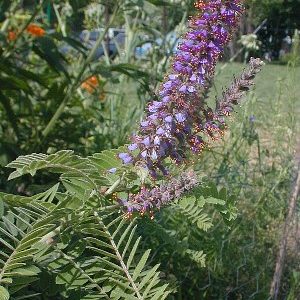
Host Plant – Silver Spotted Skipper
This is a lovely, and very long lived shrub of the prairie. The deep purple flower spikes rise above the silver-gray foliage to create a striking bloom display in June. The very deep taproot allows this plant to be very drought tolerant. Butterflies are attracted.
Available May – Mid May
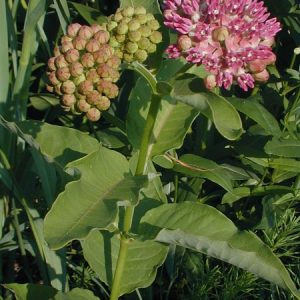
USA: AR, CT, DC, DE, GA, IA, IL, IN, KS, KY, LA, MA, MD, MI, MN, MO, MS, NC, NE, NH, NJ, NY, OH, OK, PA, RI, SD, TN, TX, VA, WI, WV
Asclepias purpurascens – Purple Milkweed is a Michigan native milkweed and is native to most of the eastern United States though it is uncommon to rare in cultivated gardens. Similar to Ascelpeias syriaca (Common Milkweed) it is an excellent garden choice due to its non-invasive nature. It has a long bloom season and the fragrant, intense rosy pink flowers attract numerous insects and butterflies. Purple Milkweed is very tolerant of a wide variety of soils and light levels making it easy to grow. It will tolerate shade, but blooms better in the sun. It commonly occurs in dry to moist open woods, dry ridge tops, thickets, glades, prairie openings, stream banks and wet meadows.
All of our plants are grown without the use of harmful pesticides and are safe for developing larvae.
Grown in 4.5″ square pot.
Available mid-late June 2017
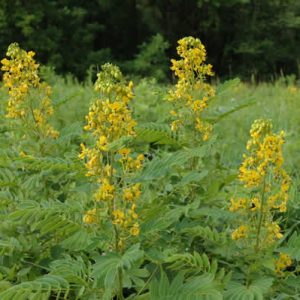
Host Plant – Sulphur, Clouded Sulphur, Orange Sulphur
Wild Senna is a versatile plant that we think deserves more recognition as a great choice for garden or restoration projects. Its lovely, bright yellow flowers bloom July-August, attracting many bees and butterflies. Autumn brings beautiful leaf colors and the formation of long black pods with seeds favored by larger birds like wild turkeys. A horizontal root system provides strength against winds, allowing the plant’s stately (4-6′) beauty to be appreciated even after the storm. Some gardeners use this sun-loving plant to form a hedge.
It is virtually indistinguishable from its relative, Maryland Senna (Senna marilandica) until the two species have ripe seeds. The Wild Senna will readily open its pod and the seeds will fall out, whereas the Maryland Senna seed pods will stay tightly closed. Other than this, it is very hard to tell the two species apart.
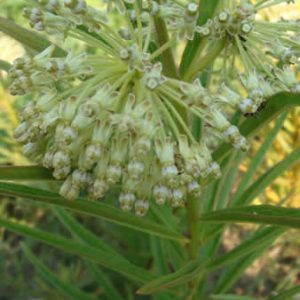
Asclepias hirtella Tall Green Milkweed is a Michigan native although it is considered threatened in the state. Tall Green Milkweed is found throughout the Tallgrass Prairie region in open areas, usually in prairies or remnants of prairies and throughout the midwest. Though not as well known as other varieties of milkweed, Tall Green Milkweed distinguishes itself with abundant clusters of green-white flowers that attract many butterflies and bees.
Other Common Names in use include Green Milkweed.
Available May 2017
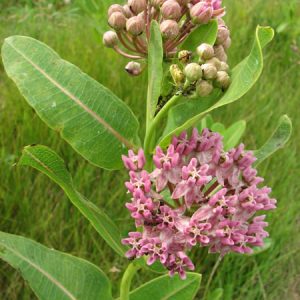
Winner of the 2015 Green Thumb Award for Best New Product!
Also known as Prairie Milkweed, Sullivant’s Milkweed is a long-lived perennial and a well-behaved relative of Common Milkweed. Very similar in appearance, it is less aggressive and an excellent choice for butterfly gardens. Prairie Milkweed grows best in a sunny, medium to medium-moist garden. The pinkish, mauve flowers are very fragrant and attract hummingbirds, bees, and butterflies. Sullivant’s Milkweed is listed as ‘threatened’ in Minnesota, Wisconsin, Michigan.
Available – May 2017
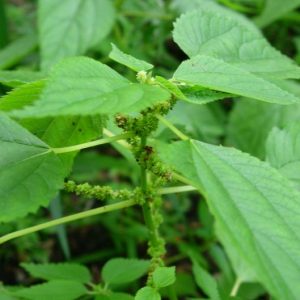
Host Plant – Red Admiral, Eastern Comma, Question Mark Preferring wet-mesic and semi-shady sites, Boehmeria cylindrica lacks the stinging hairs of some of its nettle cousins. Stringy heads of tiny yellow-green flowers form between leaf stems in summer. Moths and butterflies are attracted to this modest plant.
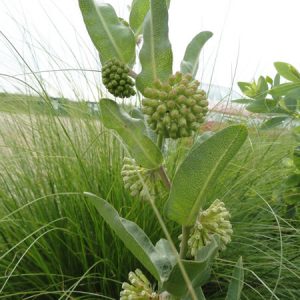
Asclepias viridiflora Short Green Milkweed is a Michigan native milkweed. While somewhat rare it has an extensive range throughout the United States. The plant matures to 1-3′ in height making it a nice choice for borders. Short Green Milkweed blooms during early summer with blooms lasting about three weeks. Flowers are light green to green and as the plant matures the flowers begin to turn yellowish green or purplish green. It prefers full to partial sun and grows in a variety of soils but prefers dry-mesic to mesic. Habitats include openings in upland forests that are rocky or sandy; upland black soil prairies, sand prairies, gravel prairies, and hill prairies; barrens, limestone glades, and sand dunes; and abandoned fields.
The flowers attract bumblebees and butterflies. Also known as Green Milkweed, Green Comet Milkweed, Green Antelopehorn Milkweed, Green-Flowered Milkweed.
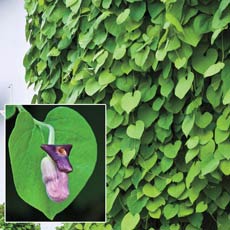
Host Plant – Pipevine Swallowtail
Culture
Easily grown in average, medium, well-drained soil in full sun to part shade. Prefers rich, moist soil. Intolerant of dry soils. Cut back in late winter to control growth. Grows well from seed.
This deciduous, woody, climbing vine is an eastern American native which typically occurs in the wild in rich, moist woods and along streams. Can rapidly grow to 20-30′. An old-fashioned favorite that is grown for its large, heart-shaped, densely overlapping leaves (6-12″ long) which can quickly cover an arbor or trellis with attractive, glossy, deep green foliage. Commonly called Dutchman’s pipe because the unusual, 2″ long, yellowish-green flowers (each flaring at the calyx mouth to form 3 brownish-purple lobes) superficially resemble Dutch smoking pipes. Although the flowers make interesting conversation pieces, they are usually hidden by the dense foliage and are somewhat inconspicuous.
